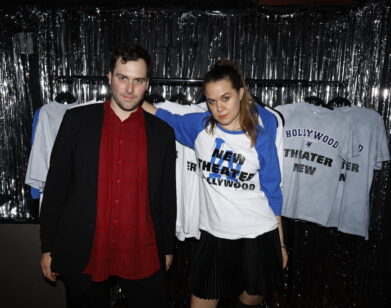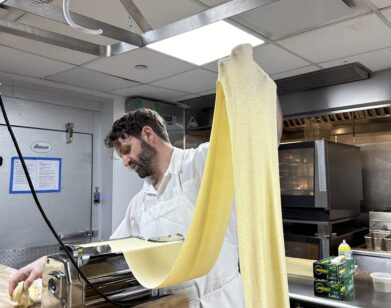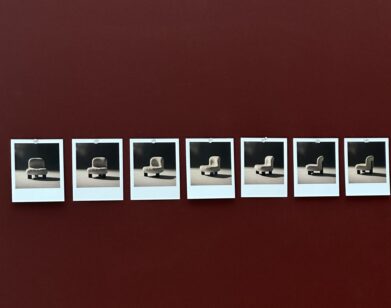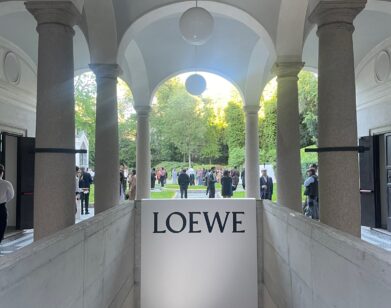Toro Scales Up
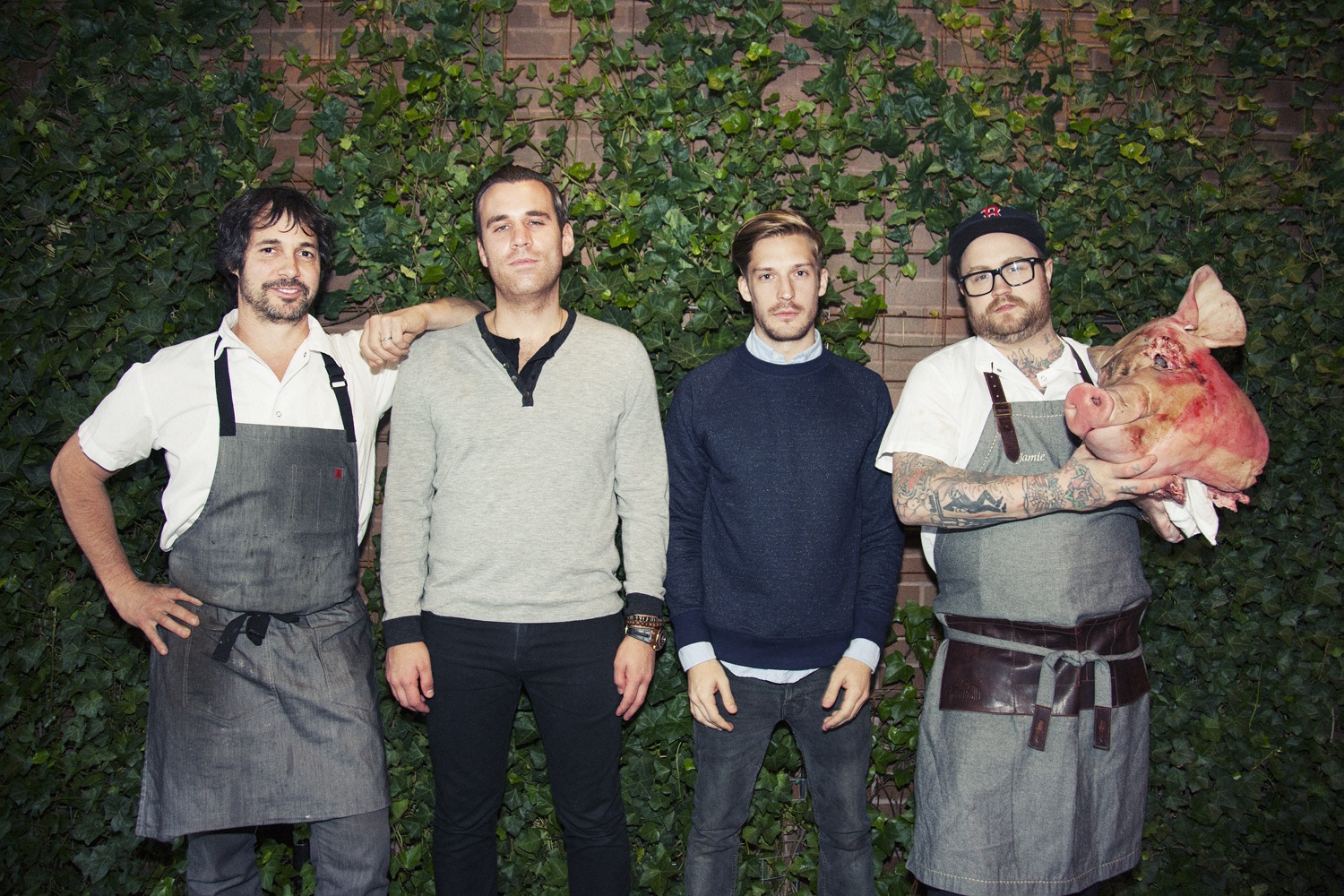
ABOVE (L-R): TORO’S KEN ORINGER, DOUG JACOB, WILL MALNATI, AND JAMIE BISSONNETTE. PHOTO BY KATE OWEN
Toro is not for the small-minded. Housed in a cavernous former factory space across from the Hudson in South Chelsea, the restaurant serves up rather exotic fare like live sea urchin, rabbit and snail paella, cock’s comb, pig ears, and “Mackerel Tartare with Stuff that We All Really Like.” The “we,” in this case, consists of chefs Jamie Bissonnette and Ken Oringer, as well as their business partners Doug Jacob and Will Malnati, and if you’re salivating yet, you might be ready for the unorthodox tapas-inspired menu Toro offers.
Not that a few offbeat items should scare you away. With six restaurants between them, it’s safe to say that Bissonnette and Oringer can deliver an expertly cooked meal peppered with surprises. “There are no rules,” says Oringer, a motto in which they’ve proven their faith many times over. In one instance, at the Italian restaurant Coppa which the partners opened in Boston in 2009, they were faced with an “okay” ravioli dish. “Cheese and tomato,” says Bissonnette. “Then we switched it to veal brains.” The dish sold like hotcakes—if those hotcakes were made from a calf’s steamed and seasoned gray matter.
Oringer and Bissonnette, a James Beard award winner and a two-time finalist, respectively, teamed up on Boston’s Toro in 2008. When Oringer set up shop in December 2005, it was among the first tapas restaurants in the area. “They wanted nachos and tacos,” describes Bissonnette. Luckily, the chefs stayed true to their idiosyncratic cooking instincts and instead proffered an out-of-the-box selection of small plates mixing varying cuisines, set against the backdrop of Barcelona tapas bar. The restaurant because popular, almost too popular, within a few months of its debut: a 2006 review in The Boston Globe berated the eatery (though praised the food) for sloppy service, seemingly due to the overwhelming crowds. A recent item, though, declared, “New Yorkers love Toro as much as we do,” in response to its good early reception. Clearly all has been forgiven.
While the menus are similar, the 120-seat, 2,500 square foot New York location–which lay vacant and growing decrepit for a decade before Jacob and Malnati scouted it out–makes for a dramatically grander dining experience compared to its snug Boston counterpart. The chefs have more elbow room to cook and experiment, and guests enjoy floor-to-ceiling windows facing the water, spacious tables, and an immense dining room to accommodate the booming atmosphere, complete with a plancha bar. The intimate 40-seat Bar Toro, which opened officially last week, has been generating buzz as a posh hotspot for exclusive events like a recent FRANK Chapter 53 dinner and DJ-socialite Hannah Bronfman’s 26th birthday party.
Before starting his career, Bissonnette was a longtime fan of Oringer, who founded the lauded Boston French restaurant Clio in 1997. After being introduced by a mutual acquaintance, the pair became fast friends, often bouncing ideas off each other. Oringer eventually brought Bissonnette on as the executive chef and partner of Boston’s Toro, and the two later co-founded Coppa.
We met with Oringer, Bissonnette, Malnati, and Jacob at Bar Toro, where we talked about travel, adventures in street food, and edible barnacles.
RACHEL SMALL: You four have been close collaborators on Toro in New York. How did you all get together in the first place?
DOUG JACOB: Will and I were partners in New York.
SMALL: Jamie and Ken, how did you two meet?
JAMIE BISSONNETTE: I had family friends who had known Ken for years. So I’d always heard his name as “our friend Ken the chef,” “our friend Ken the chef.” I was slumming it back in Hartford, Connecticut, where I grew up. Then one day I was like, “I need to go to Boston and I want to work with Ken Oringer.” He had just won the James Beard Award. My uncle goes, “Yeah that’s the Ken that we’ve been telling you about.” I was like “Oh!” So I trained at Clio and hung out a lot. I ended up working at a restaurant around the corner, but Ken and I remained friends.
KEN ORINGER: We really had the same sensibilities and real passion for food and cooking.
BISSONNETTE: We would cook for events together. He’d always take me aside: “You’re doing good food, kid, keep it up.” Then I opened up Eastern Standard in 2005 as executive chef. I was just throwing everything at it. I think I was 26 years old. I was starting to burn out. I told some of my co-workers, the managers, I need to go and do something else. They were like “What would you do?” I wanted to work for Ken, but I didn’t want to work at Clio, because it was too fine dining. Literally the same day, out of nowhere, Ken called me and was like “Hey, I got this project we’re working on. Do you want to come work with me?” And that’s what happened.
SMALL: Why did you feel like fine dining wasn’t for you?
BISSONNETTE: I like the accessibility of doing a restaurant where my friends can come in and eat all the time.
ORINGER: A more fun environment. Cooking is cooking is cooking. Good cooking is good cooking, and integrity is integrity. It doesn’t matter if you’re charging five bucks on the street for it or you’re charging $500 a head at Per Se for it. Good cooking is good cooking and that’s it.
SMALL: How did you take different inspirations from Barcelona and bring them to Toro?
ORINGER: The energy is from Barcelona.
BISSONNETTE: The food is from everywhere. We’ve taken influences from everywhere. What’s traditional and what’s non-traditional? Traditionally the word pizza comes from the word pita, and somebody making pita poorly and ended up calling it pizza. A traditional Neapolitan pizza is technically a pita. You can argue these things all day long. We try to make the things that we know tastes the best.
ORINGER: Both of us are not exactly rule-followers, so it’s not like we’re going to say, “Okay, we’re opening a Spanish restaurant, and everything we serve has to be Spanish.” Because we really don’t give a shit what people think, when push comes to shove.
SMALL: There are a lot of tapas places in New York. How is Toro different?
ORINGER: This one is definitely a little bit of a different style, again because it’s bigger. It’s probably a little higher energy.
BISSONNETTE: Whenever Ken and I are off on the same night, it’s always “Where do you want to go?” Whatever city we’re in. We like walking around the ethnic neighborhoods, where nobody speaks English. So let’s go there! The first thing we always want to do is go find a dive bar, put money in the juke box, and start our own little party. That’s what we try to do at the restaurants.
SMALL: What’s the greatest success story of those adventures?
BISSONNETTE: In Chicago. We stumbled upon a Mexican street fair and ate four or five tortes, five or six different tacos. A quesadilla. I felt disgusting.
ORINGER: Then we ate corn beef and cabbage at five in the morning. It was Saint Patrick’s Day.
SMALL: It sounds like you guys travel a lot together.
ORINGER: Always.
BISSONNETTE: It’s funny. We’ve both been to Spain a lot, and until this past June we’ve never been to Spain together. So we would always talk, “Oh, dude, there’s this place.” So we went last time, and we literally would go back and forth between what he wanted and I wanted. It was so much more fun to see all the different variety, going to two different places for pretty much the exact same dish and being like “Which one was better?” “I don’t know.” “Let’s eat it again!”
ORINGER: I’m still bumming about that tortilla place, though.
BISSONNETTE: Bar Nestor.
ORINGER: I don’t even eat eggs. That’s the only food I don’t eat, and this place that Jamie was telling me about for tortilla Española is legendary.
BISSONNETTE: It’s the only place in San Sebastian that I’ve been to probably five or six times because they sell out of it three-four hours in advance. You preorder it, and they put your name on a hand-written list on a torn piece of paper, and you go back, and they’re very particular about who they give it to. AKA, not a local, not going to get it.
SMALL: Wait, why don’t you eat eggs?
ORINGER: I think I was force-fed them when I was a kid. My mother will never admit it. I can eat an elephant’s testicles, but I just can’t eat eggs. But I love cooking eggs more than anything.
SMALL: What sort of flavors do you gear the menu towards?
BISSONNETTE: Delicious ones.
SMALL: Even more specifically.
ORINGER: There are no rules. We try not to be repetitive. Everything has its reasons for being on the menu.
SMALL: Did you tweak the menu at all to bring it to New York?
BISSONNETTE: In Boston, our restaurant, including the kitchen, can fit in the dining room here twice. Our restaurant in Boston is so tiny, and the kitchen is so small. With more space we’ve been able to expand our menu.
SMALL: Has the larger space affected you in any other major ways?
ORINGER: Sleep. [laughs] We’re definitely getting a workout.
JACOB: I think the space being unique is number one.
WILL MALNATI: I was the first person to see the space, and I got this feeling, and I called Doug right away and said you have to come see this space, and he got that feeling, and then Ken. Everyone had their own individual experience with this rawness and how unique the space was. Shaped weird. It wasn’t like a regular box. Huge windows. This space was just empty, empty. And a lot of people saw the space. A lot of restaurateurs saw the space.
JACOB: Honestly, everyone in the restaurant industry saw the space.
MALNATI: But they passed on it. Passed on it. Passed on it. Passed on it.
JACOB: The space had beautiful bones. It was cement floors. Brick walls. Cement arched ceilings. We knew that we didn’t want to over-design, but we wanted it to feel homey in the sense that these are cavernous rooms with very large ceilings. Whatever we designed with, it needed to be sort of effortless comfort, and that’s what we went with. We went with simple materials.
SMALL: What dishes are you most excited about on the menu right now?
BISSONNETTE: That’s like asking to choose your favorite kid, man.
ORINGER: There’s one dish that I recommend which I love: the tripe and blood sausage. Tripe and blood sausage are two of our favorite foods. It’s an amazing marriage. It’s so traditional, but it’s also not as heavy as people would think it is.
BISSONNETTE: We always order it when we’re in Spain. We make our own morcilla. We get great tripe. We use heirloom beans from our friend’s farm in Maine. It’s one of those dishes. It’s classic, and usually really flavorful. We’ve got a line on some really awesome seafood that you don’t see in the United States very often—espadañas, the Catalan sea cucumbers; and percebes. I am unbelievably pumped about the percebes, a gooseneck barnacle. They look like dinosaur toes.
SMALL: How do they taste?
BISSONNETTE: When you’re near a really clean part of the ocean—like, not Jersey—when you’re in a really clean part of the world, and the waves are crashing, and it’s cold, cold water, and you can smell the granite, the lime, and all the sea together—that’s what they taste like. We’ll steam them very, very gently with some aromatics and some white wine, and then warm them back up with some steaming liquid. Season them with some olive oil. That’s it. They’re so fresh and flavored. I saw them in Spain for a long time, and they’re so unbelievably expensive because of where they grow. You basically have to rappel down rocks in a wet suit, trying not to get smashed, to get them. Hand harvested. I don’t know that I’ve ever been so excited to see one singular food-thing in my kitchen.
SMALL: Besides barnacles that you have to scale a cliff to get, what else?
ORINGER: The sea cucumbers, abalone, which is not the easiest thing to get especially on the East Coast.
BISSONNETTE: We convinced our pig farmer for Boston to bring pigs with them to their farm in New York. Sandra and Ted, husband and wife couple originally from Ireland. They’ve just been doing animal husbandry their whole lives. Their pigs go and do whatever they want. They treat them like house pets. They go all over the place on their property. They feed them apples and whey from the dairy farm next store, and they use 100 percent Tamworth pigs. That breed is just really good for the way we cook, a nice sort of muscular fat. It’s not too fatty on the outside. They’re marbled really well, really red colored.
JACOB: Then they send them to Uncle Jamie’s house. [everyone laughs]
SMALL: What do you guys enjoy most about working together at Toro?
ORINGER: Well, working with Doug Jacob and Will Malnati. It’s nice sometimes to have somebody else that is watching the whole picture without us having to necessarily have our eyes on everything at all times. Doug could be dealing with legal things, or Will could be dealing with things from the contractors.
MALNATI: That goes with how big the space is too. It’s a monster space. You need a lot of different people handling a lot of different things in order for it to work properly and at its best.
BISSONNETTE: We’ve got four people who come from four different places in this industry. Four sets of eyes, and four different opinions.
JACOB: Will and I worked more on the nightlife side of the business, and then I left to start an advertising agency. We obviously stayed close friends. Then we just sat together and said, “Let’s do this.” We were in no rush. We waited till we found the best possible property and the most unique. We knew that we wanted to create something that’s food-focused. Us not coming from that we knew we needed partners that could.
MALNATI: I’ve been in it for a long time. It was never my goal to be in the nightlife side of it. I went to school for restaurants. I just came here and started off that way. We had ultimately grown into a restaurant-ish company.
JACOB: There’s something you learn from the nightlife side: It’s sort of how to cater to really difficult personalities. Not saying you guys don’t have that in food, but on a client base level, it’s making sure you understand the people and understanding how to bring them back. If you don’t do that well in the nightlife business you fail, whereas the restaurant business is more product first. [At clubs,] everybody’s pouring the same bottle of vodka. I think if we are able to create a concept that allows [Jamie and Ken] to deliver with a good time, that’s something rare.
TORO NYC IS NOW OPEN. FOR RESERVATIONS AND OTHER INFORMATION, VISIT ITS WEBSITE.

